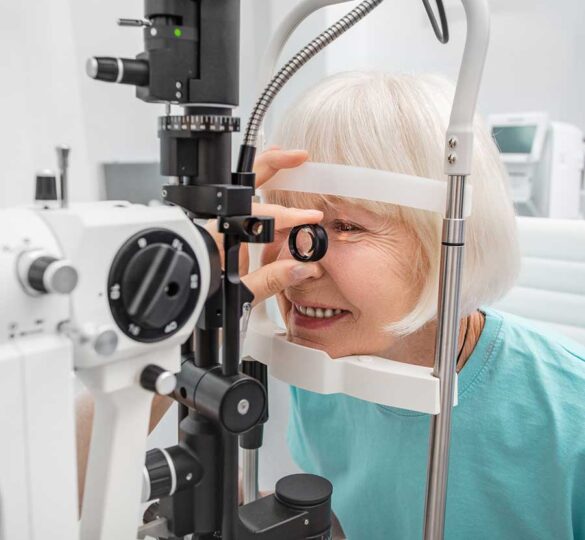Selective Laser Trabeculoplasty as Primary Glaucoma Therapy
Due to its excellent benefit-to-risk profile, selective laser trabeculoplasty, or SLT, is being offered earlier in the treatment strategy of glaucoma, including as primary therapy.

Selective laser trabeculoplasty (SLT) is an in-office procedure that reduces intraocular pressure in patients with glaucoma. The laser is applied through a special contact lens to the drainage system of the eye where it stimulates a biochemical change that improves the outflow of fluid from the eye.
SLT has been used since 1995 and has a proven track record for efficacy. On average, SLT can lower eye pressure by 20 to 30%. The laser is successful in about 80% of patients. In addition, studies have shown that SLT has a similar outcome compared to the most effective glaucoma eye drops. The treatment effect may last 3 to 5 years and SLT can be repeated when the original treatment effect diminishes.
Usually, eye drops are offered before laser for initial treatment of glaucoma. This stems from the era prior to SLT when laser trabeculoplasty was a relatively riskier procedure. Argon laser trabeculoplasty (ALT), the predecessor of SLT, delivered significantly higher laser energy to the eye resulting in structural damage and higher complication rates. By comparison, SLT has an improved safety profile where complications are typically infrequent, mild and short-lived. Although uncommon, side effects such as a “pressure spike” or inflammation can usually be successfully treated with a short course of medication.
Excellent Benefit-to-Risk Profile
Due to its excellent benefit-to-risk profile, SLT is being offered earlier in the treatment strategy of glaucoma, including as primary therapy. Studies comparing SLT and eye drops as primary therapy have found similar treatment effects between the two groups. Although some patients still required eye drops following SLT, they required fewer drops to control their glaucoma. In addition, there were significant cost savings for those getting SLT.
Many patients have difficulty with their eye drops. It is estimated that less than half of patients use their medications as regularly as directed. Medication costs, side effects, allergies, forgetfulness and complicated eye drop schedules contribute to this problem. As a result, there is a strong case for SLT as primary therapy for many new glaucoma patients. Glaucoma treatment is individualized for each patient, and SLT is not effective for all types of glaucoma. It is important to discuss your options with your eye care provider.
Article by Cindy Zheng, MD, Daniel Lee, MD, and L. Jay Katz, MD.
First posted on September 10, 2017; Reviewed on April 7, 2022.

Cindy Zheng, MD
Cindy Zheng, MD is a glaucoma specialist and cataract surgeon and at the Wills Eye Hospital Glaucoma Service. She completed her residency and fellowship in glaucoma at Wills Eye Hospital, learning the most advanced technologies available for glaucoma surgery.